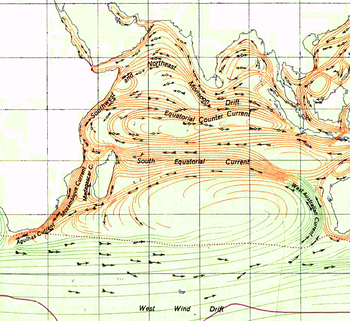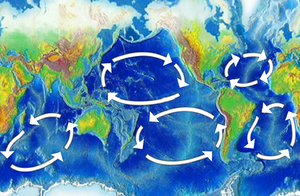Indian Ocean Gyre

TheIndian Ocean gyre,located in theIndian Ocean,is one of the five majoroceanic gyres,large systems of rotatingocean currents,which together form the backbone of theglobal conveyor belt.The Indian Ocean gyre is composed of two major currents: theSouth Equatorial Current,and theWest Australian Current.
Normally moving counter-clockwise, in the winter the Indian Ocean gyrereverses directiondue to the seasonal winds of theSouth Asian Monsoon.In the summer, the land is warmer than the ocean, so surface winds blow from the ocean to the land. However, during the winter, these temperatures reverse, making the winds blow from the land to the ocean. Because most of the air pressure gradient is retained behind theTibetan plateau,air pressure gradients over the Indian Ocean and the gyre are small. This results in winds of moderate strength, due to the protection from the full force winds blowing off the Mongolian high pressure region. Because of these moderate, dry winds, the Winter Monsoon season in the Indian Ocean region is the dry season for most ofSouthern Asia.Due to this seasonal wind cycle, the currents of the Indian Ocean, which make up the Indian Ocean gyre, are directly affected, causing reversal.[1]
Garbage patch
[edit]
References
[edit]- ^Tomczak, Matthias & J. Stuart Godfrey: Regional Oceanography: and Introduction 2nd Edition. (2003).ISBN8170353068
- ^"Ocean Geography ~ MarineBio Conservation Society".www.marinebio.org.17 June 2018.Retrieved2021-09-17.
- ^First Voyage to South Atlantic Pollution SiteSustainableBusiness.com News access-date=10 December 2021
- ^New garbage patch discovered in Indian OceanArchived2 October 2011 at theWayback Machine,Lori Bongiorno, GreenYahoo,27 July 2010
- ^Opinion: Islands are 'natural nets' for plastic-choked seasArchived6 October 2012 at theWayback MachineMarcus Eriksen forCNN,Petroleum, CNN Tech 24 June 2010
- ^Our Ocean Backyard: Exploring plastic seasArchived20 June 2010 at theWayback Machine,Dan Haifley,15 May 2010,Santa Cruz Sentinel
- ^Life aquatic choked by plasticArchived14 October 2012 at theWayback Machine14 November 2010,Times Live
- ^Moore, Charles (November 2003)."Across the Pacific Ocean, plastics, plastics, everywhere".Natural History Magazine.Archived fromthe originalon 2009-07-06.
- ^Sesini, Marzia (August 2011)."The Garbage Patch In The Oceans: The Problem And Possible Solutions"(PDF).Columbia University.
- ^For a discussion of the current sampling techniques and particle size, see Peter Ryan, Charles Moore et al., Monitoring the abundance of plastic debris in the marine environment. Phil. Trans. R. Soc. B 27 July 2009 vol. 364 no. 1526 1999–2012,doi:10.1098/rstb.2008.0207
- ^"OSU: Reports of giant ocean 'garbage patch' are exaggerated".4 January 2011. Archived fromthe originalon 14 February 2011.Retrieved7 January2011.
- ^Transoceanic Trash: International and United States Strategies for the Great Pacific Garbage Patch,Susan L. Dautel, 3 Golden Gate U. Envtl. L.J. 181 (2009)
External links
[edit]- Ocean currentsArchived2022-01-20 at theWayback Machine

